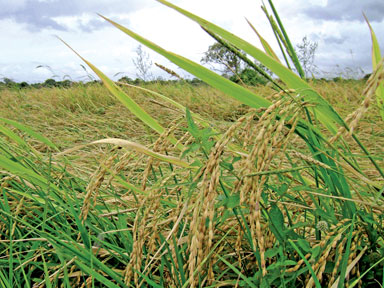Lanka should strive for high yielding paddy
by Gamini Warushamana
To meet the increasing demand for rice with a 1.1 percent annual
population growth the country should have to use new technologies such
as hybrid rice, new plant varieties, bio and genetic engineering
technologies to develop new high yield rice varieties, said Deputy
Director (Research) of the Rice Research and Development Institute
(RRDI) S.W. Abesekara.
Technology used to develop high yield rice varieties since the green
revolution has now approached saturation point, where yield cannot be
increased further under present agronomial conditions in the country.
 |
|
S.W. Abesekara |
Following are excerpts from his interview with the Sunday Observer.
Today our average yield of rice is 4.2 tonnes/hectare and according
to the population growth in the country we have to increase our yield by
1 tonne/hectare to meet the projected growth in demand of 0.8 million
tonne by 2020.
Sri Lanka has a long history of rice cultivation and according to
statistics we have achieved significant success in rice production
during the last 80 years. In the 1940s the population of the country was
six million and the rice production was 0.26 million tonnes.
The paddy cultivated land extent in the country was 0.39 million
hectares and average yield was recorded at 0.65 tonnes/hectare. During
this period we produced only 40 percent of the rice requirement of the
country and the rest was imported.
At the beginning the Department of Agriculture introduced imported
high yield rice varieties or the first green revolution varieties in Sri
Lanka. Those imported new rice varieties were not popular among our
farmers because they were short varieties.
Then we realised the importance of developing our own rice varieties
and rice research in Sri Lanka was begun in 1951. The RRDI was
established in 1953 and thereafter research was carried out in various
directions to increase yield by promoting high yield varieties, weed
control, pest control and fertiliser usage.
The irrigation systems and other infrastructure was developed
parallel and the rice cultivated land extent was also increased under
the Ministry of Agriculture and Ministry of Irrigation and departments
and institutions coming under the ministries.
As a result, by 2000 Sri Lanka became almost self sufficient in rice
and today we are producing total rice requirements for our 20.3 million
population. According to estimates total paddy production of the country
in 2010 is 4.2 million tonnes. Total paddy cultivated land extent has
increased to 0.72 million hectares and average national yield has
increased to 4.1 tonnes/hectare.
Since 2000 Sri Lanka has imported only less than 1 percent of its
rice requirement and this includes high quality rice such as Basmathi
imported by hotels. From the 1990s Sri Lanka has imported rice in bulk
only at contingencies.
During the last 80 years the population in the country has increased
by 3.36 fold, rice production has increased by 15.76 fold, paddy
cultivated land extent by 1.84 fold and the national average yield by
6.47 fold.
During the history of rice research in Sri Lanka our researchers have
developed around 60 new high yield rice varieties. However, all of them
have not become popular among the farmers.
Today RRDI has research stations in Bombuwela, Bentota, Ambalantota,
Labuduwa, Samanturai, Parantan and Murunkan. The research stations in
the North restarted after the war but still new research has not
commenced due to infrastructure issues and lack of research officers.
The objectives of each research station are different. Bathalegoda
and Murunkan research stations carry out researches for fertile lands,
Bombuwela for iron toxicated lands, Bentota-flood affecting rice lands,
Labuduwa for box soil lands and Paranthan for paddy lands with salinity.
 Ambalantota station carries out research on red rice varieties which
has a huge demand from Southern rice farmers and also focuses on inland
salinity the main issue in the area. Ambalantota station carries out research on red rice varieties which
has a huge demand from Southern rice farmers and also focuses on inland
salinity the main issue in the area.
The latest inbred rice variety released by the RRDI is BG366 or “Kiri
Samba”, a high quality rice variety which has become popular among
farmers.
Although researchers have developed high yield rice varieties the
actual yield obtained by the farmers from those varieties are below
their full potential or what was obtained on research fields. The reason
is that farmers do not provide the required agronomial conditions using
correct farming practices. For instance weed control in paddy is
essential and the field should be free of weed during the first 30 days,
the tillering stage of the crop. Yield increase can be obtained only by
proper tillering. Weeds are competitive with rice plants for fertiliser,
water and sun light.
Our high yield rice varieties have an average yield of 10 tonnes/he
but the national average is 4.2 tonne/he.
Today 98 percent of the farmlands cultivate this new improved rice
varieties. In rice research we have reached a decisive point because we
have found that it is difficult to increase the yield of inbred rice
varieties further. It has reached a maximum 10 tonnes/he.
Therefore, we have to use new technologies such as New Plant Types
(3rd Plant Types), Hybrid Rice Technology, Super High Yielding Rice, Bio
Technology and Genetic Engineering.
The International Rice Research Institute (IRRI) has already started
experiments on new plant types with 5-10 percent higher yield.The hybrid
rice technology is already popular in China, Vietnam, India,
Philippines, USA and Myanmar. The yield of hybrid rice is around 20
percent higher compared to inbred rice varieties.
Hybrid rice research of Sri Lanka is successful and in 2009 RRDI
released its first hybrid rice Bg 407H with an average yield of 13
tonnes/he. Bg 407H is a white pericarp rice resistant to many pests and
tolerant to iron toxicity. The second hybrid rice variety developed in
Sri Lanka Bg HR8 with 3.5 month maturity period will be released this
year.
The main issue of hybrid rice is that second generation seeds cannot
be used for cultivation. Farmers have to purchase F1 original hybrid
seeds every year and seeds are also expensive. However, the RRDI
introduced low cost planting technologies to farmers to reduce the
amount of seed paddy required for an acre.
RRDI has also launched programs with the assistance of the World Food
Program to form farmer groups to produce F1 hybrid seeds. Another
advantage of hybrid paddy is that the quality of the rice is high
compared to inbred rice.
Over 50 percent of the rice produced by Vietnam is hybrid. If Sri
Lanka is to export our excess rice in the future we have to improve the
quality of our rice. Rice we produce today is far below the quality of
rice consumed by other countries.
|

